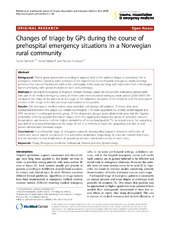| dc.contributor.author | Rørtveit, Sverre | en_US |
| dc.contributor.author | Meland, Eivind | en_US |
| dc.contributor.author | Hunskår, Steinar | en_US |
| dc.date.accessioned | 2014-09-18T11:34:41Z | |
| dc.date.available | 2014-09-18T11:34:41Z | |
| dc.date.issued | 2013-12-19 | eng |
| dc.identifier.issn | 1757-7241 | |
| dc.identifier.uri | https://hdl.handle.net/1956/8510 | |
| dc.description.abstract | Background: Priority grade assessment according to urgency level of the patients (triage) is considered vital in emergency medicine casualties. Little is known of the experiences of pre-hospital emergency medicine triage performed by General Practitioners (GPs) in the community. In this study we bring such experiences from a Norwegian island community, with special emphasis on over- and undertriage. Methods: In the island municipality of Austevoll, Western Norway, where the GPs and the ambulance services both take part in all medical emergency cases, all these cases were recorded during a 2-year period (2005–2007). We compared the triage of the patients at the stage of the telephone reception of the incident, and the subsequent revision of the triage at the first personal examination of the patient. Results: 236 emergency medical events were recorded, comprising 240 patients. Of these, 42% were downgraded between the stages (i.e. initially overtriaged), 11% were upgraded (i.e. initially undertriaged) and 47% remained in unchanged priority group. Of the diagnostic groups, acute abdominal cases had the highest probability of being upgraded between stages, while the aggregated diagnostic group of syncopes, seizures, intoxications and traumas had the highest probability of being downgraded. The principal reason for upgrading was lack of necessary information at the stage of call. In a minority of cases the upgrading was due to real patient deterioration between stages. Conclusions: In pre-hospital triage of emergency patients, downgrading happens between notification of events and actual patient examination in a substantial proportion. Upgradings of cases are considerably fewer, but the potential serious implications of upgrading warrants individual scrutiny of such cases. | en_US |
| dc.language.iso | eng | eng |
| dc.publisher | BioMed Central | eng |
| dc.relation.ispartof | <a href="http://hdl.handle.net/1956/13018" target="blank">Akuttmedisin i ein distriktskommune</a> | |
| dc.rights | Attribution CC BY | eng |
| dc.rights.uri | http://creativecommons.org/licenses/by/2.0/ | eng |
| dc.subject | Triage | eng |
| dc.subject | Emergency medicine | eng |
| dc.subject | Prehospital | eng |
| dc.subject | General practice | eng |
| dc.subject | Epidemiology | eng |
| dc.title | Changes of triage by GPs during the course of prehospital emergency situations in a Norwegian rural community | en_US |
| dc.type | Peer reviewed | |
| dc.type | Journal article | |
| dc.date.updated | 2013-12-21T12:04:02Z | |
| dc.description.version | publishedVersion | en_US |
| dc.rights.holder | Sverre Rørtveit et al.; licensee BioMed Central Ltd. | |
| dc.rights.holder | Copyright 2013 Rørtveit et al.; licensee BioMed Central Ltd. | |
| dc.source.articlenumber | 89 | |
| dc.identifier.doi | https://doi.org/10.1186/1757-7241-21-89 | |
| dc.identifier.cristin | 1094567 | |
| dc.source.journal | Scandinavian Journal of Trauma, Resuscitation and Emergency Medicine | |
| dc.source.40 | 21 | |

